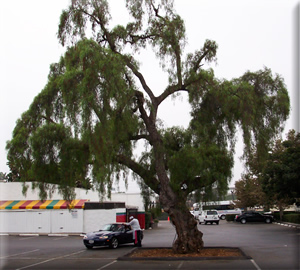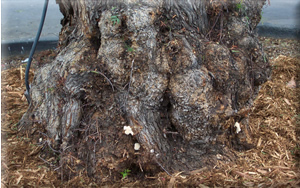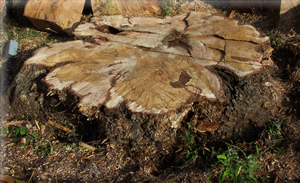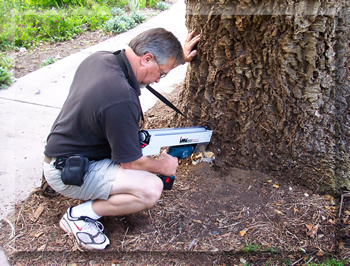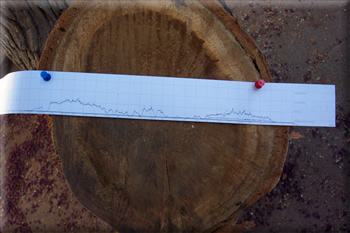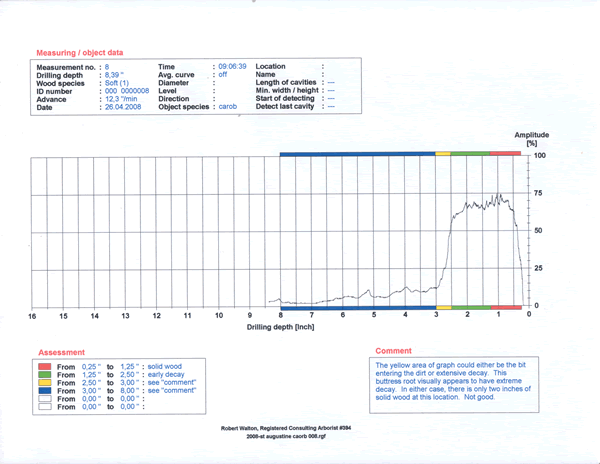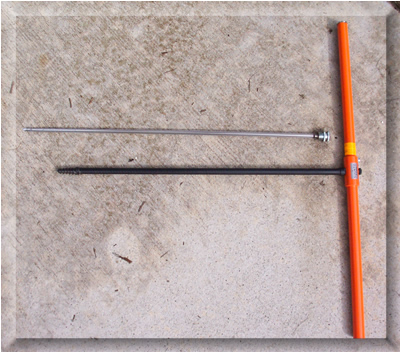| |
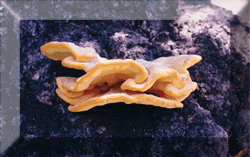 HOME
HOME |
 QUALIFICATIONS
QUALIFICATIONS |
 RATES
RATES |
 AIR-SPADE
AIR-SPADE |

EVALUATION |

TREE APPRAISAL |

EXPERT WITNESS |
| |
| |
|
|
DECAY DETECTION
& EVALUATION
Using VTA (Visual Tree Assessment), The Resistograph
and/or a Swedish Increment Bore.
|
|
|
WHY EVALUATE DECAY?
This California pepper
was located in a parking lot. The base of the trunk had Ganoderma
spp. conks around 60% of
its circumference (lower left photo) indicating extensive
internal decay. The tree was recommended for removal using
VTA. Below is the remaining stump. The
whitish wood is structurally sound wood while the yellowish
colored wood is the Ganoderma infected wood. The infected
wood is spongy and weak and would have resulted in complete
tree failure.
|
|
|
|
|
The graph to the right was taken at the
base of the above California pepper with the Resistograph. It
shows about 1.5 inches of solid wood on the outside with decayed
wood on the inside. Two other drillings showed similar decay.
|
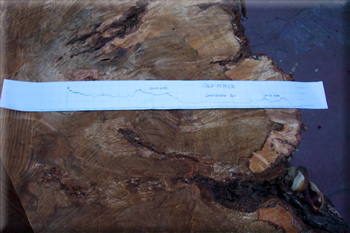
Because of decay detection and evaluation,
the tree was removed before it fell.
|
The Resistograph is one of many decay detection
techniques. It helps the arborist to better "see"
inside the trunk for advanced decay and/or cavities that may
result in tree failure without removing what may still be a
solid tree.
|
|
WHAT IS
A RESISTOGRAPH AND HOW DOES IT WORK?
|
|
|
A Resistograph
is a sensitive device that drills a
small hole (>.125 inch in diameter) measuring the
resistance of the wood to the drill bit and recording
this measurement as a graph (see the above & lower photos).
The less resistance the softer the material. The graph is then
interpreted by the arborist. The drilling graph (below) shows
how 3 to 4 inches of outside trunk-wood of this flaming flowered
eucalyptus was solid but the center was decayed with some solid
wood dead center.
|
As the decay continues
there will come a time when the decreasing percentage of solid
wood will be unable to support the stresses of the tree and
it will fail.
Decay detection & evaluation can give some forewarning.
|
|
The electronic unit on the Resistograph 400se
can also generate the computerized version seen below.
WHEN IS A RESISTOGRAPH APPROPRIATE?
Should I request one be brought to my consultation?
The appropriate use of a Resistograph is usually determined by VTA (Visual
Tree Assessment) criteria, such as visible cavities, conks (fungal fruiting
bodies), etc. that
would indicate possible interior decay. A Resistograph's use is not
always appropriate
due to its invasiveness and/or limitations. Its usefulness is determined
by the arborist
at the time of inspection. As this equipment is not normally brought
to a consultation,
the customer may request it, so that it's available if needed.
|
The Swedish Increment Bore
|
|
|
The Swedish Increment
Bore (seen to
the left with extractor) is a tool used to extract a core sample
of wood without
major damage to the core's source.
When used by the arborist, in
appropriate situations, it can tell you
things about the inner condition of
the source that cannot be found
any other way.
|
|
To the right is a core sample setting within
the extractor. Though the wood showed
solid with the Resistograph, the sample indicates the early
stages of decay.
|
 |
Visual Tree Assessment, the Air-Spade,
the Resistograph and the Swedish Increment Bore are all tools of a
comprehensive evaluation. An evaluation, while not absolute, can find
many tree defects before they become a problem.
If you are concerned about the
safety of your trees
or still have questions please give us a call.
|
![]() "When experience is important!"
"When experience is important!"
![]()

